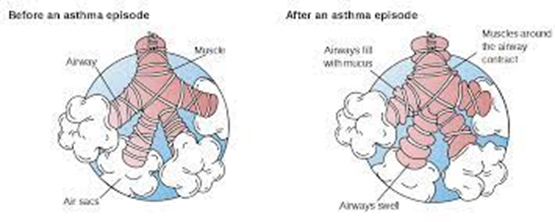A nurse is caring for a client who has a spinal cord injury and has absent bowel sounds in the lower abdominal quadrants. Which of the following actions should the nurse perform?
Place the client on clear liquids.
Perform a hemoccult blood test.
Insert a nasogastric tube.
Force the intake of fluids.
The Correct Answer is C
Choice A Reason:
Placing the client on clear liquids might not be appropriate in this situation because absent bowel sounds in the lower abdominal quadrants could indicate a more serious gastrointestinal issue such as ileus or bowel obstruction. Clear liquids may exacerbate these conditions and are not sufficient to address the underlying problem. Therefore, this option is not recommended until the cause of absent bowel sounds is identified and addressed.
Choice B Reason:
Performing a hemoccult blood test is not directly relevant to the situation described. Hemoccult tests are used to detect occult (hidden) blood in stool, which can be indicative of gastrointestinal bleeding. While it's important to assess for gastrointestinal bleeding in some cases, absent bowel sounds in the lower abdominal quadrants suggest a more immediate concern related to gastrointestinal motility rather than bleeding. Therefore, this option is not the most appropriate action at this time.
Choice C Reason:
Inserting a nasogastric tube is the most appropriate action in this scenario. Absent bowel sounds in a client with a spinal cord injury can indicate neurogenic bowel dysfunction, which may lead to abdominal distention and discomfort. Inserting a nasogastric tube can help decompress the stomach and intestines, reducing the risk of complications such as aspiration and providing relief from discomfort. It can also help manage gastrointestinal complications until further assessment and interventions can be implemented.
Choice D Reason:
Forcing the intake of fluids may not be appropriate without further assessment and could potentially worsen the client's condition if there is an underlying gastrointestinal issue leading to absent bowel sounds. Additionally, forcing fluids may not address the potential issue of gastrointestinal bleeding.
Nursing Test Bank
Naxlex Comprehensive Predictor Exams
Related Questions
Correct Answer is ["B","C","D","E"]
Explanation
Choice A Reason:
Pleural cavity decompression via needle aspiration is inappropriate. Pleural cavity decompression via needle aspiration may be indicated in cases of tension pneumothorax, a potentially life-threatening condition in which air accumulates in the pleural space and compresses the lung. While it is an intervention rather than a diagnostic tool, it may be performed emergently if tension pneumothorax is suspected based on clinical findings.
Choice B Reason:
Focused assessment with sonography in trauma (FAST) is appropriate. FAST is a bedside ultrasound examination commonly used in trauma settings to rapidly assess for the presence of free fluid in the pericardial, pleural, and peritoneal spaces. It can help identify hemopericardium, hemothorax, or intra-abdominal hemorrhage, which may be indicative of thoracic injury.
Choice C Reason:
Chest x-ray is appropriate. Chest x-ray is a commonly used imaging modality for evaluating thoracic injuries. It can help visualize abnormalities such as rib fractures, pneumothorax, hemothorax, pulmonary contusions, or other traumatic injuries to the chest.
Choice D Reason:
Thoracentesis is appropriate. Thoracentesis is a procedure used to sample fluid from the pleural space for diagnostic or therapeutic purposes. It may be indicated if there is a suspicion of pleural effusion or if fluid accumulation is seen on imaging studies such as chest x-ray or ultrasound.
Choice E Reason:
Ultrasound is appropriate. Ultrasound can be used to evaluate various aspects of thoracic injuries, including the presence of pneumothorax, hemothorax, or pleural effusion. It is often used as part of the FAST examination but can also be performed separately for more detailed assessment.
Correct Answer is C
Explanation
Choice A Reason:
Decreased mucus production contributes to airway constriction: This statement is incorrect. Bronchospasm does not decrease mucus production; instead, it primarily affects the smooth muscles surrounding the bronchioles, leading to their constriction and narrowing of the airways. Increased mucus production, often accompanied by inflammation, can contribute to airway obstruction in conditions like asthma.
Choice B Reason:
Inflammation is reduced due to airway diameter: This statement is incorrect. Bronchospasm typically occurs in the setting of inflammation in conditions such as asthma. Constriction of the airways during bronchospasm exacerbates the inflammation and can further narrow the airways, leading to symptoms such as wheezing and dyspnea.
Choice C Reason:
Bronchospasm occurs when there is inflammation, edema, and excess mucus: This statement is partially correct. Bronchospasm often occurs in the presence of inflammation, edema, and excess mucus production, as seen in conditions like asthma. These factors contribute to airway hyperresponsiveness, leading to bronchospasm and airway narrowing.
Choice D Reason:
Airway obstruction occurs due to thinning mucus: This statement is incorrect. Airway obstruction in conditions like asthma is primarily due to bronchospasm, inflammation, and excessive mucus production, rather than thinning mucus. Thinning of mucus would not typically contribute to airway obstruction.

Whether you are a student looking to ace your exams or a practicing nurse seeking to enhance your expertise , our nursing education contents will empower you with the confidence and competence to make a difference in the lives of patients and become a respected leader in the healthcare field.
Visit Naxlex, invest in your future and unlock endless possibilities with our unparalleled nursing education contents today
Report Wrong Answer on the Current Question
Do you disagree with the answer? If yes, what is your expected answer? Explain.
Kindly be descriptive with the issue you are facing.
